DAY 3
OCTOBER 24, 2024

NBAA-BACE’s convention floor remains abuzz with business meet-ups and reunions.

DAY 3
OCTOBER 24, 2024

NBAA-BACE’s convention floor remains abuzz with business meet-ups and reunions.
By Curt Epstein
Artificial intelligence’s (AI) impact on the business aviation industry promises to be profound, encompassing virtually every aspect of its operations. The different applications and their implications were threaded throughout the convention floor and industry panels during the 2024 edition of NBAA-BACE.
“Artificial intelligence has transformed from the realm of science fiction to becoming an integral part of our daily lives and industries,” said Todd Giles, Honeywell Aerospace’s
AINONLINE .
SAF challenges
Availability and cost remain roadblocks for sustainable aviation fuel adoption | 02
AAM
With eVTOL around the corner, industry sets sights on scaling operations | 08
Privacy and ADS-B Experts mull aviation security and privacy concerns in the age of flight tracking | 10
Pricing parts
Camp Systems’ AIbased parts pricing tool streamlines sales | 16
chief technology officer, at the OEM’s annual forecast event on Sunday evening, unofficially kicking off NBAA-BACE.
From enhancing pilot decision-making to increasing productivity across business functions, AI’s influence is growing rapidly, with perhaps the most profound changes coming in the safety sector.
In an NBAA-BACE panel discussion around AI first-movers on Tuesday morning, Reliable Robotics co-founder and CEO Robert Rose cited a joint study from NASA, the FAA, and the University of Tulsa that examined common causes of accidents in small aircraft and continues on page 29


By Jessica Reed
Availability and cost remain significant roadblocks to widescale adoption of sustainable aviation fuel (SAF), and a panel of industry experts at NBAA-BACE on Wednesday discussed ways of overcoming those and other obstacles as the industry strives to reach its 2050 net-zero emissions goal.
Moderated by Josh Mesinger, v-p of Mesinger Jet Sales, the discussion brought together Jabili Kandula, associate editor at Women in Aviation International; Kennedy Ricci, president of 4Air; and CR Sincock, executive v-p of Avfuel.
According to Sincock, business aviation represents approximately 5% to 6% of the total demand for jet fuel but is already responsible for 10% of SAF usage. “I think that business aviation so far is actually doing a great job on a relative basis. And the numbers
will vary based on what source you talk to,” he noted.
While the industry is adopting increasingly more SAF, it is still working o ff a very low starting point. Sincock highlighted Avfuel’s expansion of SAF availability along the East Coast, which Avfuel announced on Tuesday, following its partnership with Valero Marketing and Supply Company. This move marks a significant step in making SAF more accessible to operators outside California and the West Coast, where it has largely been concentrated.
Despite the progress, cost remains a primary barrier to adoption. Mesinger addressed the financial challenges, acknowledging that SAF carries a premium compared to traditional jet fuel.
While the price gap is narrowing as technology matures, Sincock explained that there is still a need for flight departments and corporate sustainability teams to recognize
long-term investment in SAF as a step toward operational sustainability.
“There is a cost that has to be paid. Luckily, you don’t have to bite it all at one time,” he said, advocating for incremental adoption through mechanisms like book-and-claim.
Ricci reinforced the importance of sustainability as a value proposition, especially as generational shifts occur within corporate structures. He pointed out that environmental responsibility is becoming increasingly relevant to both talent recruitment and customer relations.
“71% of millennials say climate change is a top priority to them,” Ricci noted, adding that transparency around corporate emissions has grown substantially. “Four years ago...40% of Fortune 500 companies reported their emissions publicly. Now we’re at 99%.” This increasing demand for transparency, particularly in Europe, is pressuring the business aviation sector to demonstrate leadership in sustainability.
Kandula offered a younger perspective on the issue, emphasizing that sustainability is both a professional and personal concern for her generation. “We’re pushing to be a leader in this industry for sustainability because it affects us the most,” Kandula said.
She stressed that the responsibility extends beyond corporate goals and into the daily actions of individuals. “What are you doing as an individual? What are you doing on the ground? Maybe that’s making changes, like switching to biodegradable materials in the office and in flight,” she suggested.
The panel also addressed public perception, with Kandula highlighting the common misconception that aviation is responsible for a larger share of global emissions than it actually is.
Ricci said, however, that as other industries decarbonize, aviation’s proportional share of emissions will increase, intensifying public scrutiny. “The public does think it’s much bigger…you have to back it up with the action.”
As the business aviation industry continues its path toward decarbonization, the panelists agreed that collaboration and education are key. This discussion at NBAABACE underscored the urgency of taking meaningful steps now to ensure a sustainable future for aviation.

We train yo u to sta y sharp, fi n e t une, and a lw a ys b e prep a red Thi s e m po w er s yo u w ith un wa vering ca lm ne ss and com po su re nee ded for a ll s itu a tion s, fro m the every da y to the unus ua l.
For thi s re a son , FSI tr a ining is re s erved for the s ky ’s mos t elit e.
F SI . No t hi ng shor t of e xce ll en ce.
Learn about our industry-leading training at NBAA-BACE booth 2641.

NBAA honoree Sydney Bosmans shared her story about the February Challenger crash while advocating for elevated flight attendant training.
By Jessica Reed
Corporate flight attendant Sydney Bosmans was honored with the Above and Beyond Award for Heroic Achievement by NBAA during a special reception this week for her quick thinking and life-saving actions during the Feb. 9, 2024 Hop-A-Jet Challenger 604 crash near Naples, Florida. The incident claimed the lives of both pilots, Edward Daniel Murphy and second-in-command Ian Frederick Hofmann. Thanks to Bosmans’ professionalism and training, she was able to save the two passengers on board.
After the pilots reported a dual-engine flameout, the Bombardier Challenger 604 had to make an emergency landing on the southbound lanes of Interstate 75. The aircraft collided with a concrete sound barrier. Due to the impact, the main cabin door had become stuck, and the over-wing exit was blocked by a post-crash fire.
Bosmans quickly directed the two passengers to exit through a small baggage door at the rear of the aircraft. The trio managed to escape the wreckage just moments before a secondary explosion consumed the aircraft’s fuselage in flames, according to NBAA.
During the award presentation, Bosmans
spoke publicly about the crash for the first time, delivering an emotional speech that touched on her experience, the pilots who perished, and her ongoing journey to recovery.
“This award would have not been possible without my beloved pilots, Ed and Ian—who I know are in the room right now making sure I don’t mess this whole speech up—and my passengers, who took initiative themselves and enabled us to work together that day,” she said.
Bosmans also took a moment to acknowledge the loss of the two pilots, leading the room in a moment of silence. “May we honor them and send our love and blessings to their families,” she said.
She described the trauma she continues to endure, explaining that while it has been eight months since the crash, it still feels like yesterday. She spoke candidly about the emotional and psychological toll the event has taken on her, including the struggle with post-traumatic stress disorder (PTSD).
“There are many days I still can’t believe I survived something like this. And then there are the days where I wish I hadn’t survived, the days where I wish I had perished with my pilots. I’m told this is normal for PTSD,” Bosmans shared.
She emphasized the reality that comes with surviving such a traumatic event. “My entire reality blew up when that plane did. Everything I thought I knew, all the plans I had, all the things that I had built up around my identity to keep me safe were gone just like that.”
Despite her struggles, Bosmans stressed the importance of her safety training and how it ultimately saved lives that day. She used her speech as a platform to advocate for higher safety standards and proper training for all corporate flight attendants, acknowledging the role that training played in her ability to act in the face of disaster.
“If I hadn’t made the personal and professional development decision to invest in proper safety training [for] my role, it would have resulted in five souls lost that day, and my parents would have had to deal with burying the charred remains of what was left of their 27-year-old daughter,” she said.
Bosmans also pointed out that safety training is not required for corporate flight attendants, a reality that many in the industry may not be aware of. She urged the business aviation community to reevaluate their safety practices and ensure that flight attendants are empowered to act as essential members of the crew, rather than just as cabin servers with no safety functions.
“Most people think something like this will never happen to them. And of course, I never thought this would happen to me either. But if it happened to me, it could happen to you,” she said.
Bosmans called for change within the industry, particularly in the way flight attendants are trained and how their roles are viewed. “We are just scratching the surface with these inquiries. It goes much deeper. Our industry uses accidents like ours to make improvements in aircraft and other aviation standards. And it’s my sincere hope that we can stop looking the other way on these matters,” she said.
“I know that I survived for many reasons, and while I have no clue how it looks, I know in my heart that I am meant to play a role in this,” she said. Her speech concluded with her saying, “This is not just for my pilots and passengers; this is for the entire flight attendant community. I love you all.” z

By Amy Wilder
Elevate MRO, a division of Elevate Aviation Group, has completed the installation of Starlink’s high-speed internet system on a Bombardier Global 7500, enhancing in-flight connectivity for passengers. This development follows the opening of a new maintenance, repair, and overhaul (MRO) facility at Rocky Mountain Metropolitan Airport (KBJC).
According to Elevate MRO president Jim Slack, this installation positions the company at the forefront of aviation technology. “With Starlink, we’re able to offer a seamless connectivity experience that meets the demands of today’s travelers,” he said.
Starlink Aviation, a SpaceX subsidiary, provides high-speed, low-latency in-flight internet service with global connectivity. Its download speeds range from 40 to 220 Mbps,
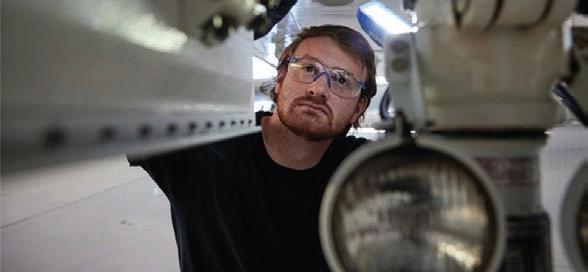
allowing multiple passengers to stream content simultaneously while maintaining latency under 99 milliseconds for activities such as video calls, online gaming, and using VPNs.
Starlink is authorized for use over international waters worldwide, while coverage over local territorial waters and land is subject to government approval. As of April 2024, regulatory approval for in-motion aviation service
Starlink applications continue to expand, including with Elevate MRO’s recent installation of the internet system on a Global 7500.
has been granted in more than 80 countries and territories.
Starlink Aviation has supplemental type certificates (STCs) available for 14 aircraft, including models from Airbus, Beechcraft, Bombardier, Embraer, and Gulfstream. More than 30 other STCs are currently in development, with approvals expected for a range of models over the next two years. z
Airbus Corporate Jets and Airbus Corporate Helicopters reported at NBAA-BACE this week that 2024 has so far been a stable year, while projecting a promising 2025 and beyond. Luis Manuel Barrajon, Airbus Corporate Jets sales and marketing director for North America, also noted that Airbus has a strong presence in the U.S. that is growing day by day.
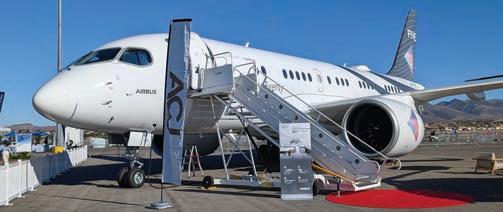
“The economic contribution of Airbus is huge,” Barrajon continued.
In Airbus Corporate Jets’ target bilinear market, Barrajon said Airbus holds about 50% of the market share. Airbus Corporate Jets expect the market to expand as utilization and the need for larger, more flexible, fuel-efficient aircraft increases.
A diverse customer base from government to corporate entities means a spectrum of needs, which Barrajon said Airbus Corporate Jets is well positioned to meet with the flex-
bility of its products. Specifically, he pointed to the ACJ TwoTwenty, which o ers 786 sq ft of cabin space and numerous configuration options and is retrofittable for future upgrades.
Frederic Lemos, head of Airbus Corporate Helicopters, cited the ACH145 as a best seller and the ACH160 emerging as “a new benchmark in the medium market.”
Lemos nodded to the recent market retraction, stating that the ACH125 and ACH130 have maintained their dominance at the light end of the helicopter market. The most recent complete
financial figures for the company are from 2023, which Lemos said were inching closer to pre-Covid numbers of 2018 and 2019. The company is seeing levels “slightly under 200 helicopters–180 aircraft, more precisely,” this year.
Bart Reijnen, president and head of Airbus Helicopters in North America, said that on average, two-thirds of market revenue has been in the medium sector. “I say, in a humble way, that we have been dominating this market over the past years,” he said.
“2023 was a cycle that was a bit down compared to our expectations,” he continued, citing global markets, inflation, and political forces as potential contributors to this. “But at the same time, our market share was strong.”
“If we move to the next five years, we expect a market of around $200 million of deliveries per year,” he said. A.W.

By Jessica Reed
A panel of advanced air mobility (AAM) experts at NBAA-BACE discussed the evolving landscape of the sector and steps necessary to scale electric and hybrid-electric aircraft operations. They focused on day-one operations, infrastructure challenges, regulatory requirements, and the potential for market expansion as these technologies move from concept to commercial viability.
Sebastien Borel, chief commercial officer at Lilium, outlined a strategy for AAM’s initial introduction. “When we looked at how to best introduce aircraft, we looked at the existing market,” he said. “We looked at the helicopter and private jet market, and that’s what we’re going after to introduce our aircraft.” By targeting routes already frequented by helicopters and private jets, Lilium hopes to simplify early-stage operations, leveraging familiar airspace and ground infrastructure.
According to Borel, this early operational strategy allows Lilium to tap into existing infrastructure. “We could work with the FBOs…we just have to add a charger,” he explained. Lilium’s aircraft fits within the dimensions of 95% of the world’s helipads.
Kyle Clark, founder and CEO of Beta Technologies, a Vermont-based developer of electric aircraft, explained how his company is setting the groundwork for scalable AAM operations by building out a nationwide charging network. Beta Technologies is already operating military missions, too.
“We went down to Duke Field in the Eglin Air Force Complex, and we flew 92 missions, 200 sorties, and 1,000 takeoffs and landings,” Clark said. While not commercial, these test flights are laying the groundwork for what will be full-scale operations in the near future.
Beta plans to deploy approximately 800 chargers nationwide to cover the contiguous U.S. “By the end of the year, 61 airports [will be] online and over 100 chargers online at airports,” Clark said, explaining the urgency of building infrastructure before aircraft enter widespread commercial service. Airports are already using the chargers for purposes such as powering electric vehicles on the ground.
Electra Aero CEO Marc Allen highlighted the regulatory hurdles that AAM companies must overcome for commercial viability. While technological progress is important, he said the regulatory landscape will play a critical role in determining how quickly AAM can scale.

“If you look around the U.S. today, 70% of traffic goes through 30 airports,” Allen said, referring to the hub-and-spoke model. “What kind of regulatory change is necessary to enable direct aviation?” He pointed to the need for reforms to make point-to-point air travel more accessible.
Electra, which is developing a hybrid-electric fixed-wing aircraft, aims to provide a viable option for short-haul routes of up to 100 nm. Allen highlighted that smaller regional airports—many of which are underutilized— could play a key role in AAM’s scalability. He noted that regulatory reform could also help keep airports open that might otherwise face closure due to noise concerns.
Borel echoed the importance of regulatory alignment, particularly on a global scale. “The issue is on the infrastructure. It’s a national authority regulation, but each country—France, Germany, and the UK, for example—has to have their own infrastructure regulation,” he said.
Tony Lefebvre, CEO of Signature Aviation, touched on the role of airports and FBOs in supporting AAM operations. “Once infrastructure and scale happens, there’s going to be thousands of these locations,” he said, adding that the “whole value proposition” of AAM is the proximity of the vehicles to where passengers want to be picked up.
While there is ample capacity to handle initial AAM demand, scaling up infrastructure will require forward-thinking planning.
Je
ff Foland, CEO of the FBO chain Atlantic Aviation, emphasized that infrastructure development must keep pace with the growing number of AAM aircraft.
“We’re not here to choose winners,” he said. “We hope everyone wins. But the idea is how to secure the right types of power, and some of the right infrastructure already exists. We can build more from that point forward.”
He added that while electrification technology is advancing quickly, there will be a need for multiple types of infrastructure, including both electric and hydrogen-based systems, depending on the application.
As the AAM industry nears commercial operations, the potential impact on business aviation is becoming clearer. Panelists repeatedly referenced the integration of AAM into existing business aviation infrastructure. z
The Vision Jet is the best-selling jet in general aviation for six consecutive years. With two Robert J. Collier award-winning safety systems, enhanced takeoff performance, the lowest operating cost in the market and approaching 600 deliveries, the Vision Jet is a proven performer.

Discover more at cirrus.link/proven

Visit us at NBAA-BACE Las Vegas Convention Center West Hall #2401 Henderson Executive Airport Booth AD108

By Amy Wilder
Industry experts discussed the evolving landscape of aviation security in the age of flight tracking for owners and operators in a panel session moderated by NBAA senior v-p of government affairs Kristie Greco Johnson.
With the implementation of the FAA’s ADS-B mandate on Jan. 1, 2020, the industry has faced ongoing challenges when it comes to keeping owner and operator personally identifiable information secure. The risks range from hacking to cyber-espionage, and the panelists laid out the challenges of protecting pilot and owner data amid the complexity of flight tracking data availability.
FlightAware founder Daniel Baker spoke about the genesis of NBAA’s Block Aircraft Registry Request (BARR) program, which allowed operators to request identifying information be shielded from public access. It is now the Limiting Aircraft Data Displayed (LADD) program.
There is also difficulty in securing flight data for operations that are not domestic. The panel called for ongoing conversations and collaboration between OEMs, third-party data providers, ICAO, and the FAA to develop solutions.
However, there are some holes in how data protections are met through programs such
as LADD. Data has ultimately been available directly from the FAA. Initially, there wasn’t a wide security risk, but now, “instead of [ADSB] data being only available from the FAA,” Baker said, “it’s available from aircraft that are broadcasting their identifications and positions.” This data can be picked up by anyone who sets up ADS-B receivers and may not be following the data security rules.
And now many of those entities are collaborating to network their receivers. “Unfortunately, one of the primary goals of those groups is to track airplanes that do not want to be tracked,” Baker said. “And that’s not limited to business aviation. It includes government, military, and other flights in general.”
Walmart v-p of aviation and travel services
Steve Saflin added that protecting passenger privacy is a shared responsibility between operators, government agencies, and information providers.
“The challenge continues to be, how do we stay ahead” of threats as technology advances, Saflin said. “Aside from an FAA request, there’s other ways out there to find information, whether it’s a hostile country or an individual, once they collect that data, to use it for unintended purposes. That can be anything from gathering insider infor-
mation or targeting somebody specifically.”
Jim Cooling, managing partner of Cooling and Herbers, highlighted the multi-layer complexity of securing data when he described a situation early in the BARR program in which a sports team owner had requested to lock his aircraft data, but it was inadvertently unlocked by a low-level manager who requested maintenance schedule information.
He also pointed to business costs resulting from data insecurity; corporate espionage (and in some cases, espionage against defense contractors, which he said are extremely reluctant to come forward with concerns) prompts operators to add extra legs to flight plans to help obscure final destinations.
Adding to this, former Dassault Falcon Jet president and CEO Jean Rosanvallon said some operators would charter the final leg to those destinations. He also called attention to the idea that “privacy, of course, is important, but security is even more important,” as some owners, operators, or passengers face threats from stalkers or protestors.
ForeFlight co-founder Tyson Weihs pointed out that any technical solution to a widespread security problem requires the entire aviation community to come together. “As a technologist, you always have a sense of urgency or interest in solving problems,” he said. “ForeFlight has done an amazing job of making the complex very simple. And the flip side of that is being in the aviation industry, developing humility, and having to develop patience for how long it takes to solve a particular problem.
“The good news is that we’re flying in a time when we’re standing on the shoulders of a ton of technology,” Weihs added. “When I started flying in 2006, I was on an old Bendix King system. I was punching buttons for the transponder. We’ve seen that evolve over time, and now we’re getting in our airplanes, devices are connecting to the avionics, transmitting flight plan information,” and so it’s worth being optimistic that the aviation community will develop solutions.
He also pointed out that this individual tracking and security concern is unique to aviation. If transponders were required on cars, “we would all be freaking out, right?…If you think about this in any other mode of transportation, it sounds bananas.” z
By Amy Wilder
Cirrus Aircraft has been advancing its flight training solutions and is demonstrating its related augmented- and virtual-reality (AR/VR) experience this week at NBAA-BACE 2024. In addition, the company is expanding its mobile units to boost support.
It launched a Cirrus-specific training course a couple of years ago and is building out AR/ VR training experiences for the Vision Jet and SR pistons. In addition to ground training, users can, for example, use Apple Vision Pro goggles to learn preflight walkaround and startup procedures, familiarize themselves with avionics, get a feel for sight pictures for maneuvers such as steep turns, and even practice talking to ATC.
Users can also select aircraft components to explode the view of systems—a selection of the jet engine, for example, renders the airframe transparent and highlights the entire fuel system, showing the lines connecting to the fuel tanks in the wings and the engine design.
The experience isn’t fully developed, but in a demo of the system at BACE, I found it to be stunningly realistic. So much so that it was difficult to keep from placing my hand against the airframe during preflight.
Development of this program was made simpler by the emergence of Apple Vision Pro technology, which is relatively easy to program for the VR space. When Cirrus CEO

Nielsen took over in 2019, he was working on his private certificate and he “sat down with Rob Haig, our chief pilot and head of training, and jokingly told him, I feel like I’m going through a divorce. I feel like I’m throwing money at something, and I don’t know when I’m done.
“One of the things that I want to do with Cirrus is drive the cost of ownership down, and the cost of ownership starts with learning how to fly,” Nielsen told AIN. “You’re learning avionics and talking to air traffic control when you’re with the instructor in the airplane, and that is the most expensive time. What if you could learn all that at home? What if you could be an avionics expert in the avionics before you set foot in the aircraft? So now you can just focus your time on stick and rudder, takeoffs and landings, slow flight, steep turns—all of that.”
Virtual learning can help alleviate plateauing during training and also enhances safety for Cirrus pilots, who can practice checklists and familiarize themselves with the avionics from the comfort of home instead of when they are task-saturated in the airplane. “Now you can actually do it with the VR glasses,” said Nielsen.
“We have yet to decide how we want to implement it in our training approach,” he
AIN staff writer and student pilot Amy Wilder takes a dive into Cirrus Aircraft’s virtual reality training during a demo at the company’s booth. She found the experience very realistic.
said. “What we don’t want it to be is gimmicky. Our training platform for the SR is very well built out, and then we have a step upwards: the type rating, which is very much driven by our classroom training in Knoxville, Tennessee, and full motion simulators.”
The training coursework is tailored for both operators and primary learners. The broader offerings include custom learning programs, recurrent training, and access to FAA-certified full-motion flight simulators supported by a network of Cirrus-certified instructor pilots.
As far as its support network, Cirrus has added a fleet of Cirrus Assist mobile units to service aircraft-on-ground events and other “break-fix” needs. The Cirrus Assist mobile units cover regions in Arizona, Florida, and Utah. This is part of a continuing effort to refine and expand its aftermarket support for the Vision Jet, the company said.
Cirrus also has continued to refine its single-jet. The Vision Jet G2+ included improved takeoff capabilities, Garmin GDL 60 for Cirrus IQ, Garmin Safe Return, inflight Gogo Wi-Fi, and AutoRadar weather detection.
Show attendees can visit Cirrus’ booth to experience a live VR training demo and go through a Vision Jet mockup.


By Chad Trautvetter
Tecnam is showing off its 11-seat P2012 piston twin this week at the NBAA-BACE static display on the heels of a spate of aircraft deliveries. In addition, the Italian aircraft manufacturer last week appointed Pasquale De Rosa as its sales manager for Europe.
Recent deliveries include a P2006T NG piston twin to Air Dream College, a flight school in Ponte de Sor, Portugal. With the addition of this Rotax 912iSc3-powered model, Air Dream has six Tecnam airplanes in its fleet and has more on option.
“As we continue to grow our international training program, we count on Tecnam’s aircraft fleet solutions as one of the key partners in our strategy. In addition, we are also asking Tecnam to option more aircraft in the same period to meet our additional needs,” said Air Dream College manager Aurélio de Almeida.
Cantor Air and Chimes Aviation—flight schools in Italy and India, respectively—each took delivery of piston-single P2010 TDIs over the past month. And Kissimmee, Florida-based flight school Buiqui Aerospace accepted five piston twins—two P2006Ts, one Lycoming IO-360-powered P2010, a P2010 TDI Gran Lusso, and one P-Mentor—as part of a batch of 20 Tecnam airplanes that will be on property by the end of second-quarter 2025. Buiqui, which also has bases in Puerto Rico, holds options for up to 30 more aircraft from the OEM.

Meanwhile, De Rosa just now oversees the company’s European sales operations and dealer network, building strategic partnerships and driving further market expansion across the region. De Rosa joined Tecnam in
2022 as marketing manager, coming from an EASA-approved design organization specializing in commercial aircraft transitions, conversions, and cabin refurbishments, where he was a sales executive. z






















Now, when you’re traveling, there’s no need to leave your life on the ground behind. Whether it’s making memories with family and friends or staying connected to business, the ACJ TwoTwenty is thoughtfully designed with the connectivity, space and range needed to get you where you need to be.
By Jessica Reed
Camp Systems, through its portfolio companies Quantum Control and Corridor, launched two tools aimed at improving the aviation parts sales process: SalesEdge quoting and the AI-based automated parts pricing tool. These technologies are designed to address critical inefficiencies in quoting and pricing, enhancing profitability for aviation parts sellers.
SalesEdge Quoting is a fully web-based module integrated with the Quantum and Corridor systems, streamlining the quoting process by consolidating RFQs from multiple sources into one easy-to-manage platform.
Aviation parts sellers often struggle to manage quotes across numerous parts marketplaces, emails, and phone calls, leading to delays and inaccuracies.
By centralizing this data, SalesEdge allows sellers to prioritize and respond to quotes more efficiently, providing real-time visibility

into customer history, pricing, and inventory.
“SalesEdge Quoting provides online automation; it’s basically a web extension of Quantum and Corridor,” Peter Velikin, general manager of Camp Enterprise Information Systems, explained during NBAA-BACE 2024. “It’s a new product, a new user interface, and it’s a quote management system. It simplifies the quoting process in a big way for sales reps so they could work fully online, they could be on their phone or remote.”
“This module serves as an extension of their ERP. What we’re doing now is a seamless extension of the ERP that is also integrated with various marketplaces. It allows real-time synchronization of inventory, sales quotes, et cetera.”
The AI pricing tool, still in beta mode, is the first offering from Camp’s new AI solutions suite. This tool automates the complex task of pricing, traditionally handled by skilled sales representatives.
By analyzing market trends, historical data,
Camp Systems executives unveiled their latest financial tools , a SalesEdge quoting and AI-based automated pricing program, at NBAA-BACE 2024.
and margin targets in real-time, the AI tool ensures optimal pricing decisions.
“It acts as a ‘spell checker’ if it sees that there is a big discrepancy between what is quoted and what it thinks it should be, and flags it,” Velikin explained. “It addresses the major challenge of complexity of pricing, and it optimizes pricing decisions in real-time.”
Camp Systems’ pricing tool validates and automates quotes and enables companies to manage large volumes of parts more quickly and with greater accuracy.
Sean Lanagan, president and CEO of Camp Systems International, stated, “We are excited to introduce solutions designed to address the core challenges aviation parts sellers face in today’s market—inefficient quoting and pricing processes.”
“Being able to understand workflows and processes and being able to leverage the data of all these different pieces is really helpful,” Velikin said. z
Private aviation industry consultancy Rolland Vincent Associates (RVA) has joined the International Business Aviation Council’s (IBAC) Industry Partner Program. Announced this week at NBAA-BACE, RVA joins 17 other aviation companies from seven countries and four continents that work with the association to further build and strengthen the global community for business aviation.
“We are delighted to join IBAC as an industry partner and look forward to contributing our analytical expertise, market insights, and industry intelligence to support the council in achieving its objectives,” said RVA president Rolland Vincent. ”IBAC is truly the
voice and conscience of global aviation.”
“Rollie and his team of analysts and market specialists led by Jennifer Nice and Dean Roberts are highly respected leaders in our industry, delivering valuable insights and unequaled expertise,” said IBAC director general Kurt Edwards. “We look forward to their support and participation in our global e orts to promote business aviation growth, safety, and sustainability.” C.E.
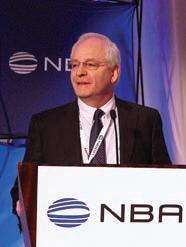
Rolland Vincent, president of Rolland Vincent Associates
By Jessica Reed
Outerlink has secured a supplemental type certificate (STC) from the FAA for its Air IP onboard Wi-Fi system on Sikorsky S-76 helicopters, the company announced this week. This approval follows previous certifications for Leonardo AW139 helicopters, further expanding the system’s reach within the rotorcraft market.
The Air IP system, equipped with a multicellular data router, provides reliable bandwidth for up to 10 devices simultaneously, even during high-speed flights exceeding 140 mph and at altitudes of several thousand feet. Its patented bonding technology ensures consistent connectivity by dynamically switching between networks and cell towers, even in challenging environments.
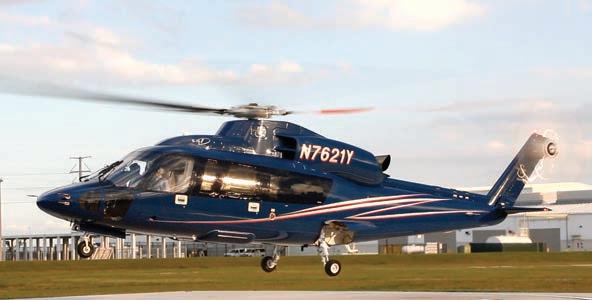
Designed for corporate operators and law enforcement agencies, the Air IP system offers HD video downlink capabilities and expanded bandwidth for uplink and return links. Optional features include Iridium satellite tracking and integration with the AXIS Command and Control platform for enhanced mapping and communications. Real-time
Outerlink’s approval for its Air IP Wi-Fi system aboard the Siksorky S-76 follows a similar nod for the Leonardo AW139.
notifications upon takeoff and landing, complete with location data, can be sent via email, SMS, or WhatsApp.
Sterling Helicopters, responsible for both the AW139 and S-76 installations, developed an installation kit to streamline operator adoption. Outerlink is showcasing its Air IP system this week at NBAA-BACE. z





By Curt Epstein
The aircraft market is consistent and stable, according to aircraft brokers speaking in a panel discussion on current market conditions on Tuesday at NBAA-BACE in Las Vegas. “We feel like demand is very strong right now,” said Don Dwyer, co-managing partner at Guardian Jet. “We’re having our biggest year ever.”
He believes that it wasn’t just Covid that brought the entrants to business aviation but the underlying 15-year economic bull run as well. “It’s that creation of wealth that fuels our business, we haven’t seen that go away.”
While the used jet inventory is rising following the record lows of the pandemic, there is no sign of panic selling, according to Brad Harris, president and CEO of Dallas Jet International. “We’re seeing a lot of supply increase, but when you were at 2% [of the fleet on market] and now we’re back up to 6% or 7%, it’s still a seller’s market, and one thing we are seeing is the prices aren’t diminishing rapidly.”
“There’s definitely more supply than there was at the peak, which was the end of 2022,
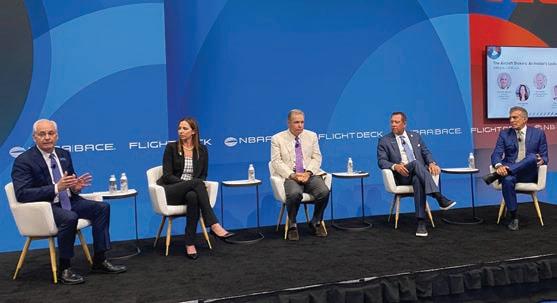
and since January 2023 the market has been definitely getting more inventory, but it’s still less inventory than it was before Covid started,” explained Steve Varsano, founder of The Jet Business. “When there was nothing available, people had to buy stuff they didn’t want to because they didn’t have any other choices. There’s a much better product available [now] than there was in the peak.”
He noted that aged aircraft are not inherently unsafe, but the question is how long the maintenance facilities will service the equipment on the aircraft before you have to start
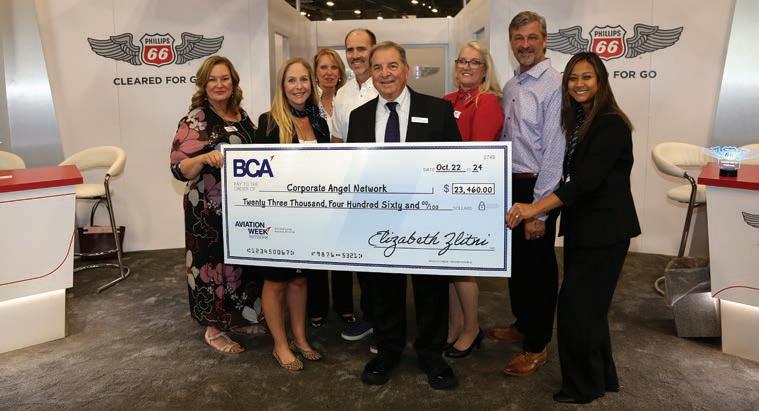
Industry veteran Robert Stangarone—the newly installed president and CEO of Corporate Angel Network (CAN)—accepted a $23,460 check on Tuesday from Phillips 66 Aviation at the company’s NBAA-BACE booth. Since 2010, Phillips 66 has donated more than $280,000 to the charity, which arranges transport to treatment for cancer patients on donated business aircraft flights.
Despite rising inventory, demand for preowned business aircaft remains strong, according to brokers. It’s still a seller’s market, but buyers are also benefitting from more choices in the marketplace.
replacing it. “This is where the cost of ownership and operating becomes much more expensive than the value of the airplane.”
In the post-Covid boom, there was much discussion over the “stickiness” of the new private aviation users—whether they would remain after the threat of the pandemic subsided and commercial air travel resumed.
“There was this great concern that a lot of those people were going to leave—this was the question everyone was asking for a couple of years, and I think we would all say total opposite,” said JetAviva CEO Emily Deaton. “They’ve not only stayed, they’ve continued to repeat purchase. They’re fully committed to remaining in the industry because they found that they absolutely need it to continue to live the way they want to live whether that’s for business or personal use. That has been a huge thing that has helped support demand as well.”
Regarding the stability of the market values, Dwyer noted, “People are not expecting to make money on their airplane now. They’re not losing their shirts, either. But if you have something that the market’s in demand—a super-midsize, large cabin—we see it holding well.”
Harris said one trend has been the return of corporate flight departments to the buyer’s market over the past year and a half, resuming fleet replacement schedules that were interrupted by the pandemic and eyeing the pre-owned market. “Some of the corporates are saying, ‘I don’t want to pay $10 million more for this brand new airplane, I want preowned, and then you’ve got the guys that say I want preowned, I’m not willing to wait two years.’” z
By Amy Wilder
Electra Aero will soon unveil the nine-passenger version of its hybrid-electric short takeo ff and landing (eSTOL) aircraft after extensive testing of a two-seat prototype. The aircraft’s turbogenerator and eight wing-mounted electric propulsion units place it between an eVTOL and a traditional fixed-wing aircraft in performance and mission scope.
Speaking at NBAA-BACE 2024, Electra CEO Marc Allen said the aircraft can use existing fuel infrastructure, including sustainable aviation fuel (SAF), and is not reliant on charging stations on the ground to operate.
Virginia-based Electra originally developed a turbocharger in-house but partnered with Safran in June 2023 to develop a propulsion system for the platform. The hybrid-electric system combines a gas-powered turbogenerator with battery packs, which allow for in-flight or ground charging and can be adapted for SAF or hydrogen in the future.
This technology also significantly reduces operating noise. “You’re going to see us demonstrating 75 dBAs at 300 feet and 55 dBAs at 500 feet,” said Allen, “which is quieter than a car passing by on the street.”
Allen was quick to clarify that this is not a powered-lift aircraft, despite its hybrid propulsion technology, takeoff roll as short as 150 feet, and steep climb ability. “This is a fixed-wing aircraft. It’s just an airplane,” he said. According to Allen, the aircraft will have a range of up to 1,100 nm, or 350 nm with a full load of passengers and cargo; its maximum payload is 2,700 pounds. Its cruise speed is about 175 knots.

The electric propulsors mounted on the wings change aerodynamic performance and allow for lower operating speeds, with controllability at as low as 30 knots, said James “JP” Stewart, Electra’s vice president and general manager. “It’s not like a catapult on an aircraft carrier. You’re talking about going from a stop to 35 miles an hour—very, very comfortable. But once you put the flaps up, your airplane is a conventional airplane. It goes 175 knots, and you can carry nine passengers.”
Mark Allen (right), CEO of Electra Aero, said the company’s forthcoming hybridelectric short takeoff and landing aircraft will be able to run on sustainable aviation fuel, meaning it is not reliant on electric charging stations to operate.
Fly-by-wire flight controls are an important design component for controllability during landings and at slow airspeeds. “We’ve also flown as slow as about 22 knots,” said Stewart, “and we haven’t found the stall yet. So we’ll keep giving you updates as we get slower and slower.”
The big reveal for the nine-passenger design is slated for November 13 at 5 p.m. EST at Manassas Regional Airport in Virginia. z







By Curt Epstein
Among the companies making their NBAABACE debut this year is Business Jet Transport, a firm that provides turnkey aircraft ferry services.
Launched last year, the company is a subsidiary of Jet Test, which has provided the same type of business model for the commercial aircraft market for the past two decades. During that span, Jet Test had been called upon to provide ferry services for private jet aircraft in enough instances that Heath Barnett—a typerated pilot in the Learjet 45, Learjet 60, and Bombardier Challenger 300 series—convinced it to spin off a separate company for the business aviation segment alone.
“Basically, we deliver,” said Barnett, who serves as its CEO. “If you bought a new aircraft and you don’t have a flight crew or anything set up and you need it transported, we’re the people you call because we handle every aspect of that delivery from the pilots to the permits.”
The company focuses solely on jets and as such can draw on its parent company’s experience. One benefit of that is the ability to operate flights under its own callsign, which means that all airspace fees and permitting costs are billed directly to Business Jet Transport rather than the customer.
“We know pretty much how much it’s going to cost to get that aircraft delivered, including every aspect—the permits, the fuel, everything—and we can put it all on one invoice,” Barnett told AIN . “That helps the brokers
communicate to their clients how much it’s going to cost. We supply the invoice and the transaction happens. There’s no mail coming to them for overflight fees; we already know how much that costs and we’ve already paid it.”
Additionally, the company has its own contract fuel network and can even arrange and oversee return-to-service maintenance on the aircraft.
With dozens of jet types still in service, the Henderson, Nevada-based company has established a roster of contract pilots to meet any demand. “You must have an unblemished safety record and extensive international aircraft ferry experience,” said Barnett. “These are operations that need experience, so we have a really extensive vetting process.”
In one recent mission, the company delivered a nearly 40-year-old Learjet 35A from Fort Lauderdale, Florida, to Germany. In this instance, Business Jet Transport was hired by a broker on behalf of his client, who operates a fleet of vintage Learjets for use in military target training.
The customer requested “full comprehensive services” that included crew leasing and all travel arrangements (such as catering, hotels, and return airfare), third-party maintenance coordination, international flight planning, import and export assistance, ground handling requests, and fuel contracting.
Barnett’s crew even flagged up the aircraft’s non-compliant radios. “We can put an airplane anywhere in the world,” he said. “You just tell us where, as long as it’s not a war zone.” z
Highlighting Gogo’s market expansion plans with the upcoming acquisition of Satcom Direct, Gogo chief operating o cer Sergio Aguirre shared that this was the third—finally successful—attempt to secure a deal to buy the connectivity and communications provider. Speaking to reporters during NBAA-BACE, Aguirre explained that issues such as debt payments hindered previous e orts.
He opened the briefing on Gogo Inflight’s acquisition of Satcom Direct with a question posed to the gaggle of reporters present. “So, what do you all think of the news? Were you expecting it? What does the industry think?”
He also pushed back on the notion that the merger was spurred by the increasing prevalence of Starlink in the space, saying that conversations about a merger began before the company—a subsidiary of Elon Musk’s SpaceX—became a player.
“This was not an acquisition based on defense,” he said, “We’re on fullon o ense.”
He added the company is not focused on acquiring Starlink’s customer share but on the 70% of customers who do not currently have wireless connectivity in the market.
“This has nothing to do with Starlink, but it sure is going to make their life hard,” he said.
Bigger questions like where the company will eventually be headquartered were left open-ended for now.
Under the agreement announced on September 30 and to close by yearend, Satcom Direct will receive $375 million in cash, five million shares of Gogo stock at closing, and up to an additional $225 million in payments tied to performance thresholds. S.R.
By Charles Alcock
As part of efforts to clear logjams delaying support for business aircraft engines, RollsRoyce recently started using an additional hangar to keep its CorporateCare power-bythe-hour customers flying. The facility has allowed the manufacturer to fast-track North American operators with additional slots available to handle short-notice tasks, such as engine changes.
The initiative introduced in recent months has quickly made a difference to the extent that Rolls-Royce is now looking at where else it could add more hangar capacity in regions including Europe. The first hangar is located at Indianapolis Regional Airport, which is not too far from the company’s existing facility in the city.
Despite the fact that Rolls-Royce already has 85 authorized service centers worldwide, Lindsey Gillan, v-p of sales and marketing for business aviation, said it has sometimes proved hard for operators to secure a convenient slot, and the company also needs to keep lease engines maintained and ready for use. “We’re expanding availability because we want to provide support to CorporateCare and CorporateCare Enhanced customers whenever and wherever they need it,” she told AIN.
The extra capacity is part of a wider $1 billion investment Rolls-Royce has made in its business aviation service network. It has been looking to further boost its support offering since launching the CorporateCare Enhanced program in January 2019 to respond to customer demand for closing gaps in what work and materials are covered for the BR and Pearl family of turbofans.
The manufacturer now has an inventory of 250 engines and nacelles available to lease and located in parts stores worldwide. The most recent addition was a facility at New York JFK International Airport, where the whole operation runs from a service center in Germany on a 24/7 basis. It employs more than 80 OnWing service technicians who can be dispatched worldwide to provide local support.

Another improvement is the introduction of the new Engine Network app that Rolls-Royce technicians use to access comprehensive information about the current state of every engine they support. The platform constantly draws engine health monitoring (EHM) data, covering more than 9,000 engine parameters and all replaceable parts covering 3,800 aircraft in service with some 3,000 customers.
Rolls-Royce is using an additional hangar to increase maintenance capacity and alleviate support backlog for CorporateCare power-by-the-hour customers in North America.
“It shows everything about the work that has been done, and the EHM data means we can be far more predictive and less reactive in how we support customers,” Gillan said. “We can know when and how something is going to happen with an engine, and that is helping us to achieve better reliability and availability and improve time on wing.” z



By Kerry Lynch
West Star Aviation has taken a novel approach to building its next-generation workforce, establishing an academy in partnership with Southwestern Illinois College (SWIC) to train individuals to receive their airframe mechanic licenses and bring them on board as apprentices.
Under the 7.5-month program, students complete a customized Part 147 airframe maintenance curriculum in a dedicated West Star classroom through SWIC and also receive hands-on training in one of the MRO’s hangars at its East Alton, Illinois facility, working with standard tools and other components including a Falcon aircraft. To further bridge the gap between classroom and real-world experiences, apprentices receive mentoring and shadowing opportunities.
Prospective apprentices are screened, interviewed, and hired into a full-time paid position through the program. As they graduate from West Star Aviation Academy (WSAA), they are ready to test for their airframe license.
In fact, the first class of 23 that graduated last month already have ordered their tool
kits to embark on their new careers with West Star. West Star kicked off the program earlier this year and has welcomed the next 25 students who will complete their coursework and hands-on training in the second quarter of 2025.
By providing a paid position as they are training, West Star said, the apprentices can fully focus on developing the necessary skills rather than having to balance work and training. With a tailored curriculum, graduates are prepared to join the MRO with hands-on experience with West Star’s aircraft, systems, manuals, and procedures.
“We’ve learned a massive amount about how aircraft work, how to repair them, and how to perform maintenance. The knowledge we’re gaining is very applicable to our work,” said David Magg, the first student to test and pass his mechanic certificate and airframe rating through WSAA.
“The academy has been great, from the learning aspect to working in the hangar and the camaraderie of the classroom. All in all, the whole experience has been pretty amazing,” added WSAA graduate Kyle Kovorick.
WSAA credited its strong partnerships with
SWIC and community organizations for the program. “WSAA has set a new standard for aviation education, combining academic excellence with practical, hands-on experience,” said Brad Sparks, dean of the aviation program at SWIC.
Along with West Star’s support, the program has received assistance through the Madison County Workforce Innovation Board. “By securing support through grants, recruiting efforts, and advertising, we were able to provide West Star with some of the resources they needed to ensure WSAA was a success,” said Tony Fuhrmann, director of the board.
As WSAA kicks off training for its second group of apprentices, the company is eyeing future expansions of the program as it continues to grow rapidly.
“We’re proud to offer unique opportunities for individuals to develop their skills and launch successful careers in aviation,” said Katie Johnson, chief people officer at West Star Aviation. “WSAA is a testament to our commitment to investing in our people and ensuring the continued excellence of our workforce.”
The program becomes particularly important for West Star as it continues to grow. In August, the company held a ribbon-cutting ceremony on a new $20 million, 75,700-sq-ft hangar that increases its capacity for interior, avionics, and sheet metal services and facilitates implementation of new edge production technologies. The hangar is expected to result in the addition of 60 to 80 new jobs.
Throughout its facilities, West Star employs more than 3,000. z
By Kerry Lynch
Embry-Riddle Aeronautical University (ERAU) recently reopened its Robertson Simulator Center after a complete overhaul that will bring new technologies, the latest in simulation, and new capabilities serving some 1,000 flight students at its Prescott Campus in Arizona.
Parker Northrup, chair of the flight department at Prescott, called the effort a “100% renovation of our legacy simulation capability” to enable new simulation technologies, optimize learning space, and provide scalable architecture that could accommodate a range of simulations from the most basic to a level-D flight simulator.
Adding to its inventory of cockpit procedure trainers, basic training devices, and advanced aviation training devices (AATD), the university plans to bring on additional RedBird AATDs, along with three more Frasca AATDs, which Northrup said will be fullmotion-based platforms for student training
in the university’s primary aircraft, including Cessna 172S Skyhawks and Diamond DA42-VI Twin Stars. However, space is also provided for the campus’ first level-D simulator, which Northrup told AIN is on a “longer acquisition timeline” but will likely involve a regional jet that so many students eventually step into as they embark on airline careers.
But the key to these efforts is the advancements they bring in simulation. “All of the simulation devices in the building are either upgraded by the OEM or being replaced by new equipment to leverage advances in visual graphic generation, control loading technology (how the sim “feels” like an airplane), and environmental controls (for example, we included smoke generation devices to simulate a fire in the cockpit),” he explained.
The renovation also takes place as the university continues to forge new paths in areas such as virtual reality (VR) training and artificial intelligence (AI). Northrup said the training
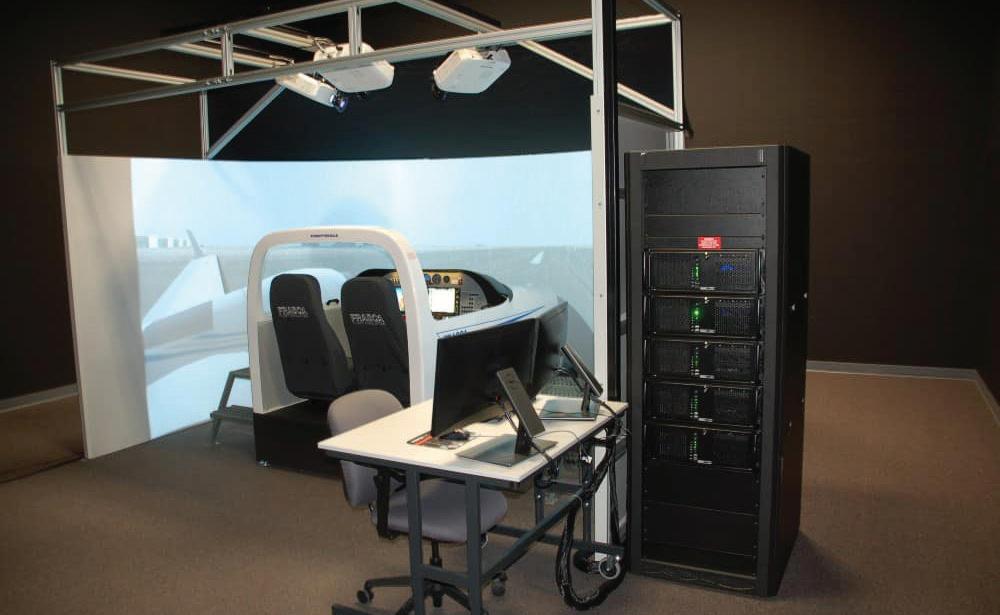
department has completed its experimentation with the adaptability and integration of VR technologies and is pursuing a full “fleet” of VR devices to fill the gap in devices such as desktop training and instructor-controlled simulators.
“VR supports our effort to completely digitize the flight training and learning environment,” he said, and will be connected to its “Prescott Synchronized Training and Learning Environment”—an initiative to collect comprehensive data to enable the center to digitally twin student training and tailor and adapt instructors as a result. Plans call for implementation of the VR capability in the third quarter of 2025.
The VR capabilities build on lessons learned from the implementation at ERAU’s Daytona Beach, Florida campus. “We had the advantage of learning from their introduction of VR technologies to their environment, as well as the simulated air traffic control educational experience. We work together to ensure the high quality and caliber of training exists at both campuses.”
Rolled out in August 2021, ERAU immediately began seeing the benefits of the use of VR. ERAU College of Aviation assistant dean and chairman of the flight training department Ken Byrnes reported that the early results of the use of VR in its flight training curriculum had shown a 28% decrease in training time to solo. Students were “very prepared” for flight, he said, with significantly better radio communication skills—something emphasized during the VR training—and had lower anxiety as they began training.
Along with a center renovation, EmbryRiddle’s Prescott campus is updating its simulation capabilities, including getting new Frasca trainers to support its fleet of Diamond DA42-VI Twin Stars and Cessna 172 Skyhawks.
Beyond the simulation and training advances, ERAU’s Robertson Simulation Center at Prescott also was designed to house advanced data gathering, storage, and replication of cyber technologies. Partnering with the College of Security, Business, and Intelligence on campus, the university can further its research in data analytics, trust protocols, multi-source data fusion, machine learning, and “narrow” AI development to support training, Northrup added.
The university already has other AI initiatives underway, including research to model and predict in-flight loss-of-control incidents at its Advanced Dynamics Control Lab. It is also used to teach flight students to communicate with air traffic control and other pilots. z
By Charles Alcock
Hourly cost maintenance provider JSSI is marking the 10th anniversary of its Parts & Leasing division. What started as an in-house procurement unit now has more than 100,000 business aircraft parts in stock, including more than 70 engines and APUs that it leases to operators. This inventory is housed in warehouses around the world to expedite access for the U.S. company’s customers. JSSI now has sourcing relationships with more than 600 vendors. Last year, JSSI launched its new PartsHub e-commerce platform that draws on maintenance intelligence data the company compiles from several thousand aircraft. This data includes the reliability records for individual parts to help predict inventory needs across the fleet the company supports.
Since it opened, PartsHub has been used for upwards of 14,000 searches resulting in quote requests worth more than $21 million. As well as being used by JSSI’s internal team, the free-touse system is accessed by individual operators and providers of maintenance, repair, and overhaul services.
In response to input from customers, JSSI has further refined its procurement processes with the introduction of a rotable program that provides analysis of a client’s needs to help them to optimize inventory planning. The company has
also upgraded its supply chain solutions service that allows clients to hire JSSI staff to handle all aspects of parts buying, including core returns and warranty claims.
“The JSSI supply-chain team enables my maintenance control team to focus on the aircraft issues as opposed to parts logistics,” said Eric Bewersdorf, v-p of fleet maintenance at George J. Priester Aviation. “Their ability to find odd parts and parts near obsolescence is a key factor in our customer experience. The partnership we have with JSSI is only improving our operational ability.”

Sean McGeough JSSI’s
executive v-p of
business development in North America
This month, JSSI boosted its leadership team with the appointment of industry veteran Sean McGeough as its new executive v-p for business development in North America. McGeough joins the group from Airbus Corporate Jets, where he was commercial v-p, and he has previously held senior management positions with Wheels Up, Aerion, Nextant Aerospace, and Hawker Beechcraft.
McGeough told AIN that in his previous jobs he has seen JSSI’s involvement in
Fort Worth, Texas-based Trimec Aviation is developing a supplemental type certificate for the installation of Gogo’s Galileo HDX satcom system in the super-midsize Gulfstream G200. Gogo Galileo is scheduled to begin service by year-end and runs on Eutelsat’s OneWeb lowearth-orbit (LEO) satellite network.
aircraft transactions growing, whether through the hourly cost program or the provision of finance and spare parts. “They make everything more seamless, and especially for first-time aircraft buyers, offering an extension to [a customer’s] flight department or maintenance team,” he explained.
In his view, this support is vital, and especially at a time when the value proposition of business aircraft is increasingly scrutinized. “Some of the new clients who came into the market during Covid got the shock of their lives when the first aircraft maintenance bills came in,” McGeough recollected. “There are no surprises with JSSI.”
In previous incarnations, McGeough has worked well beyond North America and has seen for himself what it means to have the right backup. “When I was in Africa, I couldn’t get a King Air or a Hawker sold unless there was an [hourly cost] engine program available,” he recounted. “What JSSI does is all about relationships, as I’ve seen for myself.”
JSSI has also appointed David Caporali to the new role of senior v-p for Conklin & de Decker and strategy. The company’s Conklin & de Decker unit provides independently-gathered data related to business aircraft operating costs and performance. z
The half-duplex HDX electronically steered antenna is the smaller of two antennas that Gogo will o er for its Galileo service. Made for turboprops to larger jets, it weighs 21.6 pounds and measures 24 inches long, 11.8 inches wide, and 2.1 inches high. A larger, full-duplex FDX antenna—at 40 to 45 pounds, 30 inches long, 24.6 inches wide, and 2.1 inches high—will be available in the first half of next year and will provide faster service speeds. The antennas are installed on the top of the fuselage.
“We are excited to work with Gogo…to provide our G200 customers with an easy upgrade option to the latest satellite connectivity technology,” said John Holland, general manager of Trimec Aviation. M.T.
MEBAA Show, the Middle East’s premier business aviation event, returns this December for its 10th anniversary edition bringing the business aviation community together to take advantage of the significant growth in the region.



By Amy Wilder
At the NBAA-BACE in Las Vegas, the industry-wide Climbing Fast campaign welcomed the Canadian Business Aviation Association (CBAA) as its newest member. The alliance aims to advance the industry’s commitment to achieving net-zero carbon emissions by 2050. CBAA becomes the second international partner to join Climbing Fast, following the European Business Aviation Association’s membership earlier this year.
“CBAA is thrilled to be part of the Climbing Fast mission in Canada, which helps propel the industry forward through groundbreaking innovation in sustainability,” said CBAA CEO Anthony Norejko. NBAA president Ed Bolen added that the collaboration is vital for highlighting the industry’s global sustainability leadership.
In addition to the partnership announcement, Climbing Fast unveiled its inaugural annual report, showcasing its achievements over the past year in engaging policymakers. The campaign continues to foster international collaboration on regulatory issues and sustainability innovations. z
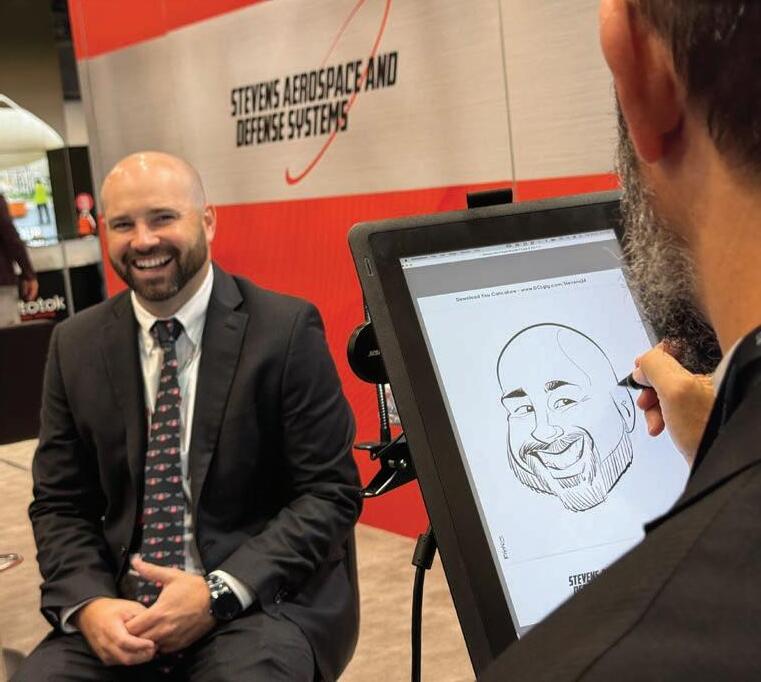
A confluence of events caused Gulfstream G700 deliveries to lag by 11 units in the third quarter, according to Phebe Novakovic, the chairman and CEO of Gulfstream Aerospace parent General Dynamics. As a result, planned overall Gulfstream deliveries this year have been contracted from 160 to 150 as forecast G700 shipments fall from 52 to 42. In the first nine months, the company handed over 89 jets (76 large cabin models and 13 super-midsize G280s), up from 72 (57 large cabins and 15 G280s) a year ago.
Novakovic said during the company’s third-quarter investor call on Wednesday morning that only four of the planned 15 G700 deliveries occurred during the quarter. She explained that this was due to paint rework as engine delivery delays led to aircraft being painted before engines were installed, as well as additional type certification procedures due to complex interiors, a quality escape from a vendor that required replacing 16 parts on each aircraft, and four lost workdays after Hurricane Helene.
The revised schedule going forward calls for deliveries of 27 G700s in the fourth quarter, with Novakovic breaking it down by month: five in October, nine in November, and 13 in December.
Despite the G700 delivery challenges, General Dynamics’ aerospace division— which includes Gulfstream and Jet Aviation—saw third-quarter revenues climb year over year by 22.1%, to $2.482 billion, and earnings up 13.8%, to $305 million. For the first nine months, aerospace revenues soared by 27.7%, to $7.506 billion, and earnings rose 19.9%, to $879 million, from a year ago. C.T.
By Jessica Reed
Sherwin-Williams Aerospace Coatings has introduced a range of new products and services at this year’s NBAA-BACE under the theme “Envisioned Precision.” Among the highlights are advanced coatings and tools designed to make the aircraft finishing process more efficient and to offer more aesthetic options for aviation professionals.
At the forefront of its product launches is the 850 Series Skyscapes Effect Finishes, a high-performance polyurethane base coat offering a wide variety of effects for use on both small and large aircraft. The new line allows for versatile application, including striping, accents, and overall paint jobs, providing a durable, vibrant finish with metallic and hybrid options. It was designed to be easy to apply and to repair. “It’s all about helping

the OEM and the maintenance facility get it done quicker and out the door,” Julie Voisin, Sherwin-Williams market segment manager for aerospace, told AIN
Complementing the 850 Series is the new 858 Series Skyscapes single-stage topcoat, designed for both exterior and interior surfaces. This polyester/urethane hybrid system offers a range of gloss levels, delivering a durable and smooth appearance that meets the diverse needs of aviation maintenance and repair shops.
Sherwin-Williams also unveiled updates to
Sherwin-Williams is rolling out an array of advanced coatings to offer more versatile paint jobs.
its Aircraft Color Visualizer, a web-based tool that allows users to experiment with color combinations on various aircraft models. The system now supports 10 aircraft types, including everything from kit planes to heavy jets.
In addition, Sherwin-Williams is introducing a next-generation chrome-free epoxy primer, designed for corrosion resistance without the environmental drawbacks of traditional chrome-based systems. Also new is the Jet Prep Sol-Gel metal pretreatment, adhesion, and corrosion protection system. z

Enroll your engines with EAP and get where you need to go.
Our highly skilled and motivated team now includes exclusive access to rapid response field units. It’s just one of the EAP extras that help maintain your engines so that you maintain your flight schedule. We have the team, the parts and the rental engine pool to keep your asset in the air. In fact, we have the highest percentage of rental engines to enrolled engines in the industry. An EAP engine maintenance program is proactive protection for your schedule. With EAP, you have the power.
Visit us at NBAA-BACE in booth 1031. Call 214.350.0877 or go to eap.aero to see the complete list of engines we cover
By Amy Wilder
Ed Jenkins, managing director of Aviation Search Group, a direct-hire aviation recruiting company, joined the business—and the wider aviation community—in March 2024. His career background involves working as an executive recruiter in the business sector. At NBAA-BACE 2024 (and at home), he is focused on filling leadership roles for companies looking for executives for Part 91, Part 135, FBO, flight school, or private charter operations.
When a recruiter reached out to him about filling the role at his current company, he was intrigued by aviation. “I thought that aviation would be an amazing field to get into and to explore, and it’s been even better than I imagined,” he said. “It’s such a cool industry and there’s so much opportunity.”
Jenkins had zero previous background in aviation and doesn’t have one of those stories about falling in love with airplanes at an early age. Entering a new field has brought with it a learning curve, “but the cool thing about not having a background in aviation is that every day, I learn something new,” he said. “I’m engaged; it’s exciting. I listen to conversations that other people have and just learn.
“And the cool thing right now is about the transition of new talent—younger talent that’s coming into this industry,” Jenkins said. “They see things a little bit differently. So you have a generation of traditionalists, and then you have a generation of newbies that are coming in. That’s fun to watch—multiple generations are able to assimilate into aviation and make it all work.”
Jenkins pointed to some potentially groundbreaking ideas he’s seen on the sales
If you’ve ever wanted to get your game on at 20,000 feet, Innovative Advantage has paved the way with an audio, video, and data distribution system (AVDS) the company is introducing at NBAA-BACE this week.
Innovative Advantage’s mission objective is simple: Make high-speed gaming happen on business aircraft. At the company’s booth in the exhibit hall, BACE attendees can see how games on consoles like Xbox can be played on private aircraft.
“We’re gonna let people play video games through our system and see. If you know any hardcore gamers, latency frame rate is a really, really big deal to them. So they can come and see that it’s perfectly in sync; there’s low latency,” Greg Cornell, president of Innovative Advantage, told AIN. Cornell noted that younger generations are beginning to fly private, and with that, demand has grown for low-latency capabilities. “Our systems are uniquely positioned to allow for some really cool capabilities.” S.R.

and charter side of the business. Some companies, he says, are really creative in the way they structure their charter services in particular, which is different from the way things were 20 years ago. “I think charter sales now has become this new thing and everybody is finding a new creative way as to how to do it and how to make it appealing and affordable to a much larger audience,” he said. “Now it’s more accessible.”
What he loves most so far is discovering that everyone in the industry genuinely loves what they do. And there’s no gatekeeping—people with knowledge and insights are eager to share and lift others up in their careers. z
FBO chain Modern Aviation accepted its first all-electric refueler this week at NBAA-BACE. The 5,000-gallon Rampmaster tanker is just the second fully electrified jet-A refueler in the world, with the first being delivered to Signature Aviation earlier this year. Modern’s truck was unveiled in the exhibit hall on Tuesday.
“We’re excited to get this refueling vehicle,” said Eric Schneider, general manager of Modern Aviation at Boeing Field (KBFI) in Seattle. “This is another example of the partnership between Modern Aviation and King County to move closer to our overall environmental objectives.”
He noted that the FBO’s customers might not notice a di erence in the new vehicle’s appearance from a conventional diesel-powered truck as it arrives, except that the electric truck is quieter, reducing noise as well as emissions. C.E.

Modern Aviation’s all-electric refueler will head to its permanent home in Seattle after NBAA-BACE.
determined that 68% of those accidents could be prevented with advanced automation systems. He added that the top causes of fatal accidents in small aircraft are controlled flight into terrain (CFIT) and loss of control in flight.
“Our first certification is a continuous autopilot engagement system, an always-on autopilot is targeted in preventing those first two causes of fatal accidents in small aircraft.” In addressing CFIT, he explained, “You’ve got an autopilot that is tightly coupled with your flight management system, and it’s crosschecking your flight path to make sure you are keeping a safe distance from terrain and other aircraft.”
Rose noted the AI autopilot would not allow the aircraft to exit its operating envelope. “Then loss of control is no longer a thing, so you’ve got roughly a third of fatal accidents in small aircraft are eliminated right there.”
“Eventually, we’re going to put that technology into aircraft and enable you to remotely pilot it so that the pilot is on the loop rather than in it,” said Rose. “2027 is when we are targeting having our first operations of our remotely piloted system for the Cessna Caravan,” he said.
“I think the big misconception is we’re not looking to eliminate humans or eliminate pilots. It’s just about moving the pilot out of the cockpit and putting them in a control center and allowing them to do their job more effectively,” Rose added.
AI’s role in assisting pilots during flight is also coming into focus. Trung Pham, chief scientist for AI and machine learning at the FAA, noted that while AI hasn’t yet reached the point of fully operating aircraft, it is already making strides in augmented intelligence.
“With an AI system, the system can see more than what we can focus on and inform us in a role of monitoring what’s going on—and inform us of certain precursors that can lead to accidents or incidents,” he said.
“We think the human is going to be part of this equation for a long time—there are things humans do just naturally that are really hard to do,” said Jon Damush, president and CEO of uAvionix. He said the question is how to use AI to simplify the cockpit, separate out menial chores, and allow them to concentrate on the hard tasks.

Merlin, backed by Google, is developing a nonhuman pilot system to serve as an autonomous third “pilot” in the cockpit, with the goal of eventually enabling single-pilot operations in most aircraft. The company is already working with the U.S. military to reduce crew size on aircraft like the C-130J and KC-135R.
AI technologies such as computer vision are also enhancing the ability to inspect aircraft components that are otherwise difficult for humans to assess, thus improving safety and efficiency. Damush said his company is working on a ground-based aircraft detection system to help pilots recognize threats. “There is no data set out there for that; we had to go get it,” he told the audience.
“We literally flew airplanes at each other and at our ground stations over 17,000 times, and then we built some specialized tools for humans to go in and say that’s a Cessna, that’s a helicopter, that’s a bird, etc.” That data is uploaded to the system which then finds all the permutations of the images and builds classifiers.
Likewise, Daedalean is building perception systems that are designed and integrated with artificial intelligence. “What we bring is what we call situational intelligence explained Yemaya Bordain, the company’s president for the Americas.
“What a human does is anticipate and react to future threats,” Bordain said. “We are taking our traffic detection algorithm and we’re implementing it in a traffic collision avoidance system,” essentially acting as a second set of eyes for the pilot. Daedalean’s system identifies “non-cooperative” traffic, such as birds, drones, hot air balloons, or even paragliders on the traffic display along with any aircraft with a transponder. She said Daedalean
AI remains a popular theme throughout NBAA-BACE, with a Flight Deck panel probing multiple facets of its use in business aviation.
expects to introduce this technology into the market within the next year and a half.
Bordain noted that Daedalean owns a small fleet of aircraft that it flies constantly to collect data and refine its database—which she described as the company’s most valuable asset—to improve its AI system accuracy. “We keep all of that in-house, and it’s probably the most valuable asset within our company.”
AI is extending to the maintenance realm as well. Pratt & Whitney recently launched an AI-based aircraft engine analysis tool for geared turbofan and V2500 powerplants. Called Percept, the inspection tool combines computer vision technology with a video intelligence operating system developed by Indian AI start-up Awiros.
The company’s maintenance technicians use a cloud-based interface on a mobile device to capture images of an engine, and the app provides real-time parts availability status. According to Pratt & Whitney, Percept has reduced the time it takes to conduct an engine inspection by nearly 90%.
In another example, Honeywell Aerospace recently began using AI and machine learning to help manufacturers and MROs modernize their processes and save costs by leveraging data to inform critical decisions. Honeywell unveiled the cloud-based software solution, called Forge Performance+, in April as an addition to its Forge suite of digital tools for aerospace manufacturers and MROs.
“If you go to any one of our websites, you’ll see that we are demonstrating capabilities that have never been done before,” Bordain concluded. “They are beyond what anyone thought could exist. So it’s happening right now, and each one of us is working on how we can certify those systems and ensure that they’re safe.” z
By Kerry Lynch
StandardAero is commemorating 50 years of supporting Pratt & Whitney Canada’s (P&WC) JT15D engine family that has powered Cessna Citation and Hawker business jets. More than 6,700 JT15Ds have been produced over the past five decades, equipping Citation I/II/V/Ultra and Hawker Beechjet 400 business jets along with trainer aircraft, demonstrators, and uncrewed aerial vehicles.
Dallas Airmotive—which StandardAero acquired in 2021—became a P&WC-designated overhaul facility for the JT15D in 1974. Now, StandardAero additionally supports the JT15D at its overhaul facility on Prince Edward Island in Canada as well as through 10 service centers
across the U.S., Brazil, the UK, Singapore, and Australia.
StandardAero also maintains P&WC PW300 and PW500 business jet engines at its Dallas-Fort Worth facility.
“StandardAero is proud to support the global JT15D operator community with cost-effective maintenance, repair, and overhaul support for this popular powerplant,” said Jeff Poirier, v-p and general manager of the turboprops and fleets business unit for StandardAero. “With over 2,000 JT15D-powered aircraft still in service, StandardAero’s network of engine facilities ensures that operators are still able to depend on a reliable source of engine MRO, both today and tomorrow.” z


Execaire celebrates its partnership with Avfuel.
Execaire Aviation’s FBO at Toronto Pearson International Airport (CYYZ) will join the Avfuel-branded FBO network starting November 1. This partnership, made o cial on October 22, brings together two aviation services leaders.
Execaire Aviation provides services in aircraft management, maintenance, charters, and sales across North America. Partnering with Avfuel, an independent supplier of aviation fuel and services, enhances its ability to o er competitive fuel pricing, rewards through the Avtrip program, and seamless transaction processes via the Avfuel Pro Card.
“Avfuel is thrilled to partner with Execaire Aviation in supporting Toronto’s aviation community,” said Joel Hirst, Avfuel’s senior v-p of sales. “Our shared values of professionalism and innovation will set new standards for the industry.”
Execaire president Michael Fedele noted, “The partnership combines the strengths of two industry leaders, and together, we will deliver the highest standard of service excellence in the Toronto market.”
The company’s FBO at CYYZ o ers a modern facility that includes private parking, more than 80,000 sq ft of heated hangar space, and 24/7 customer support. J.R.












AIN Media Group is excited to announce our inaugural









March 27, 2025 | The National WWII Museum | New Orleans, LA

Join us for AIN’s FBO Dinner & Awards Gala, a prestigious event dedicated to celebrating excellence in the business aviation industry, as we announce the top performers from our survey.
The event will take place on Thursday, March 27th, 2025, from 6 pm to 9 pm in the U.S. Freedom Pavilion at The National WWII Museum in New Orleans. This exclusive evening will feature a formal dinner and an awards ceremony.
This event promises to be an unforgettable night of networking, recognition, and celebration among the leaders in aviation.

Voting us #1 in Product Support says we’re doing things to your level of expectation, making each journey easier. Rest assured, we’ll continue working to improve your every Bombardier experience, too.